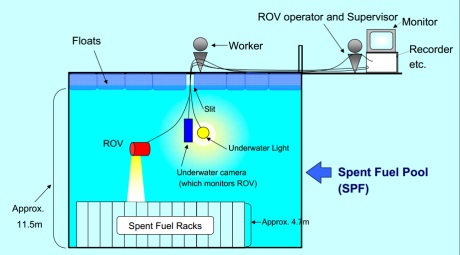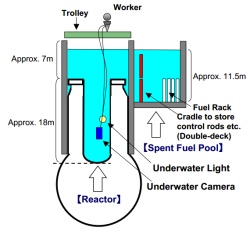The fuel pond of Fukushima Daiichi 4 will be inspected by an underwater robot this month as an early step in the program of work to remove the used nuclear fuel from the building.
Unit 4 had been out of service at the time of last year's natural disasters; its reactor vessel open and emptied for inspection with all its fuel assemblies and control rods transferred into the adjacent storage pond. The pond contains 1331 fuel assemblies, but the higher heat load from the 548 more recently used fuel assemblies made the pond more of a concern than those at the other three damaged reactors. For the same reason the pond now represents a high priority for Tokyo Electric Power Company (Tepco) engineers that are working to ultimately decommission the site.
As with most reactor decommissioning projects, priority is placed on the removal of used nuclear fuel because this is the single step that makes the biggest difference to the safety of the site as a whole. Used nuclear fuel contains the vast majority of radioactivity at any nuclear power plant, Fukushima included.
 |
| Tepco's explanation of how it will use the robot remotely operated vehicle (ROV) to check the status of the used fuel stored at unit 4 |
Tepco plans to send a small camera-equipped robot made by GE-Hitachi Nuclear Energy through the depths of the 11.5 metre-deep pond on 19-21 March. The fuel is thought to be undamaged and visual inspection may confirm this, although the amount of debris that has landed on top of the fuel racks is another item of major interest.
Tepco has been removing heavy concrete and steel debris that once made up the roof of unit 4, making access easier to the service floor that now represents the top of the containment as well as the de-facto roof of the building. Floats have been placed across the pond surface to prevent more dust and debris getting in, but floating silt obscures the view into the pond for workers. Underwater cameras have confirmed visibility of about five metres.
 |
| The empty reactor vessel will also be checked for debris, perhaps using the robot |
Aiming to remove the fuel for long-term storage in the Fukushima site’s shared used fuel pond, the company hopes to remove the reactor control rods from the pond. The idea is to put these back into the still-open and undamaged reactor vessel, but again this will depend on the amount of debris there. Tepco expects to use underwater lights and cameras to survey the reactor vessel, but may instead use the robot.
Second priority for fuel removal is unit 2, whose building remains largely intact, although heavily contaminated after its torus suppression chamber was ruptured by an assumed hydrogen explosion on 15 March 2011. The intact service floor was surveyed by a tracked robot, recording radiation levels as it went.
Elsewhere on site, Tepco engineers have trialled a method of covering up the seabed in the power plant's water intake area, which was contaminated by leaks of the highly radioactive water from the building basements. Apart from areas like this that are alongside the station, sea monitoring now reports no detection of radioisotopes from the plant due to effective dilution by ocean currents.
Researched and written
by World Nuclear News




_16403_79272.jpg)


_69218.jpg)

_76087_55556.jpg)



